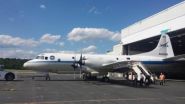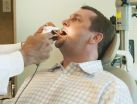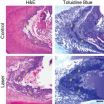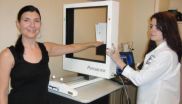(Press-News.org) Researchers with NASA's Operation IceBridge have completed another successful Arctic field campaign. On May 23, NASA's P-3 research aircraft left Thule Air Base, Greenland, and returned to Wallops Flight Facility in Virginia marking the end of 11 weeks of polar research.
During this campaign, researchers collected data on Arctic sea and land ice – both repeating measurements on rapidly changing areas and expanding coverage into new, unsurveyed regions. The mission also released two sea ice data products and provided a professional development opportunity for three science teachers.
Starting With Sea Ice
IceBridge's campaign began on Mar. 10 when NASA's P-3 research aircraft left Wallops for Thule. For the first part of the campaign, researchers studied Arctic sea ice from Thule and Fairbanks, Alaska.
Early in each campaign IceBridge spends a week in Alaska to survey sea ice north of Alaska. In addition, researchers study sea ice conditions across the entire Arctic Basin traveling from Thule to Fairbanks and back.
IceBridge's sea ice measurements help researchers understand how Arctic ice is changing, particularly those forecasting how sea ice coverage will change over the summer. To meet the need for timely ice thickness measurements IceBridge releases a quick look data product before the end of the campaign that gives an almost real-time look at sea ice.
This quick look product first debuted in 2012 and is joined this year by a new data product that uses IceBridge data together with measurements from the European Space Agency's satellite, CryoSat-2, to show ice thickness across the entire Arctic Ocean. The new CryoSat-2 data product compares well with IceBridge's quick look data, which Nathan Kurtz, sea ice scientist at NASA's Goddard Space Flight Center in Greenbelt, Maryland, said is nice to see.
Looking at the Land
After surveying sea ice for four weeks, IceBridge turned its attention to land ice southern half of Greenland, moving its base of operations to Kangerlussuaq. From there researchers spent three weeks surveying the ice sheet and coastal glaciers such as Jakobshavn Glacier, the most rapidly-changing ice stream in Greenland.
Nearly half of the surveys flown from Kangerlussuaq fell into a new category known as baseline missions, which are to be flown each year. The seven baseline missions covered areas experiencing dramatic change, such as Helheim and Kangerdlugssuaq glaciers on Greenland's east coast and the Jakobshavn region in the west. These flights were joined by two surveys designed around future ICESat-2 ground tracks, giving researchers measurements to help connect datasets from IceBridge, ICESat and ICESat-2.
The Helheim and Kangerdlugssuaq baseline flight was of keen interest because of prevailing weather conditions in the area, so mission planners kept an eye on the region. "We tried it to get it every day for three weeks and never saw a good opportunity to go for it," said John Sonntag, Airborne Topographic Mapper senior scientist, at NASA Goddard.
But on the last day of the Kangerlussuaq deployment, the forecast showed that cloudy conditions in the southern part of the survey area would clear for a few hours. By rearranging the flight plan the team was able to move arrive in those areas as they cleared and collect data over the entire flight line.
A Learning Experience
While in Kangerlussuaq, IceBridge also hosted three high school science teachers – one each from the United States, Greenland and Denmark – who joined the team to get a closer look at IceBridge's science. This was the third year that IceBridge has provided a research experience for teachers, who plan to take what they learned back to their students.
Russell Hood, a physics teacher from Anchorage, Alaska, came to Kangerlussuaq through the National Science Foundation-funded PolarTREC program, an education organization that teams qualified teachers with scientists doing research in the Arctic and Antarctic. PolarTREC strives to improve science education by giving teachers a first-hand look at real-life research and promoting collaboration between scientists and educators.
Since returning from Greenland, Hood has been busy preparing for the end of the semester and is currently planning future classroom activities based on his experiences with IceBridge. "I am planning some lessons that begin with an overview of IceBridge and end with my students using archived data to research and draw some conclusions," said Hood.
Back North
On Apr. 25 the IceBridge team packed up and returned to Thule for the last four weeks of the campaign, this time focusing mostly on land ice. During this span the team collected data on coastal glaciers in northern Greenland and the Canadian Arctic and parts of the Greenland Ice Sheet, with one flight to measure sea ice near the North Pole.
IceBridge flew several repeats of previous missions – such as surveys of Petermann and Humboldt glaciers – which is vital for understanding long-term changes to ice sheets and glaciers. Researchers also carried out new missions, measuring bedrock shape in northeast Greenland and covering a new set of lines to be measured by ICESat-2.
With 46 survey flights in the books, IceBridge returned to Wallops where instrument and aircraft technicians started removing instruments from the NASA P-3. Researchers will now spend the next few months processing data from the campaign and mission planners will start getting ready for IceBridge's future campaigns.
In late August, a new airborne mission known as the Arctic Radiation - IceBridge Sea and Ice Experiment, or ARISE, will begin. ARISE will use a large suite of instruments to collect data on the atmosphere and on Arctic sea ice. In October, IceBridge will return to Punta Arenas, Chile, to survey Antarctic ice, and next March the mission will return to Greenland, this time aboard NASA's C-130 aircraft.
INFORMATION:
For more information about NASA's IceBridge Mission, visit:
http://www.nasa.gov/icebridge
NASA IceBridge concludes Arctic field campaign
2014-05-28
ELSE PRESS RELEASES FROM THIS DATE:
International collaboration highlights new mechanism explaining how cancer cells spread
2014-05-28
DALLAS – May 28, 2014 – UT Southwestern Medical Center cancer researchers have identified a protein critical to the spread of deadly cancer cells and determined how it works, paving the way for potential use in diagnosis and eventually possible therapeutic drugs to halt or slow the spread of cancer.
The protein, Aiolos, is produced by normal blood cells but commits a kind of "identity theft" of blood cells when expressed by cancer cells, allowing the latter to metastasize, or spread, to other parts of the body. Metastatic cancer cells have the ability to break free from ...
Suspect strep throat? Re-check negative rapid test results with lab culture
2014-05-28
Clinical guidelines conflict on testing teens and adults whose symptoms point to a possible strep throat. A chief contention is whether negative tests results from a rapid analysis of a throat swab, done in a doctor's office, should be confirmed through a follow-up laboratory culture.
The rapid test detects certain antigens, one of the body's efforts to fight off strep bacteria. Attempting to grow bacteria from a throat specimen double checks for the presence or absence of Group A Streptococcus bacteria, as well as a few other bacterial infections.
A study published ...
Negative social interactions increase hypertension risk in older adults
2014-05-28
PITTSBURGH—Keeping your friends close and your enemies closer may not be the best advice if you are 50 or older.
New research from Carnegie Mellon University's Rodlescia Sneed and Sheldon Cohen shows that unpleasant or demanding interpersonal encounters increase hypertension risk among older adults.
Published in the American Psychological Association's journal Health Psychology, the study provides some of the first concrete evidence that negative social interactions not only influence psychological well-being but also physical health – in this case, blood pressure ...
T cell repertoire changes predictive of anti-CTLA-4 cancer immunotherapy outcome revealed
2014-05-28
Sequenta, Inc. today announced publication of a study done in collaboration with researchers from UCSF and UCLA that used the company's proprietary LymphoSIGHT™ immune repertoire sequencing platform to investigate the effects of anti-CTLA-4 antibody on the number and types of T cells present in a patient's blood. The results, which appear in the May 28 issue of Science Translational Medicine, shed light on the mechanism of action of this type of cancer immunotherapy and suggest that immune repertoire sequencing could be used to predict which patients will have improved ...
Study: Amphetamines can delay exhaustion during exercise in the heat -- at a cost
2014-05-28
Indiana University researchers put male rats to the test to determine the role amphetamines play when used in conjunction with exercise.
When people or animals exercise in the heat, exhaustion is a safety gauge telling the body it is time to stop. Exhaustion occurs when the body's core temperature reaches a potentially dangerous point. The use of amphetamines is banned in many sports because they increase time to exhaustion.
What they found: Amphetamines can delay exhaustion during exercise in the heat by increasing the temperature at which it occurs. This potentially ...
Researchers use light to coax stem cells to repair teeth
2014-05-28
A Harvard-led team is the first to demonstrate the ability to use low-power light to trigger stem cells inside the body to regenerate tissue, an advance they reported in Science Translational Medicine. The research, led by Wyss Institute Core Faculty member David Mooney, Ph.D., lays the foundation for a host of clinical applications in restorative dentistry and regenerative medicine more broadly, such as wound healing, bone regeneration, and more.
The team used a low-power laser to trigger human dental stem cells to form dentin, the hard tissue that is similar to bone ...
EARTH magazine: The history, science and poetry of New England's stone walls
2014-05-28
Alexandria, Va. — When author John-Manuel Andriote returned to his hometown in New England after years away, he noticed something that had been invisible to him while growing up there — the old stone walls tumbling off into the forests. The realization that the crumbling and overgrown walls meant those forests had once been cleared farm lands set Andriote on a years-long journey of discovery that highlights the intersections of geologic and human history.
The story of New England's stone walls begins with the glaciers of the last ice age, meanders through the Colonial ...
Some high blood pressure drugs may be associated with increased risk of vision-threatening disease
2014-05-28
SAN FRANCISCO – May 28, 2014 – There may be a connection between taking vasodilators and developing early-stage age-related macular degeneration (AMD), the leading cause of vision loss and blindness among Americans who are age 65 and older, according to a study published online in Ophthalmology, the journal of the American Academy of Ophthalmology.
AMD – the deterioration of the eye's macula, which is responsible for the ability to see fine details clearly – affects an estimated 11 million people in the United States. In addition to increased age, the cause of AMD ...
NYU researchers pilot educational and behavioral program to reduce lymphedema risk
2014-05-28
Viewed as one of the most unfortunate outcomes of breast cancer treatment, lymphedema is characterized by an accumulation of lymph fluid in the interstitial spaces of the affected limb, leading to chronic ipsilateral limb swelling causing psychosocial distress and physical challenges for patients.
Even conservative estimates suggest that 3% of women who have had sentinel lymph node biopsy and 20% of those who have had axillary lymph node dissection may develop lymphedema a year after breast cancer surgery. Two established risk factors for lymphedema are compromised ...
A cure for dry eye could be a blink away
2014-05-28
A treatment for dry eye—a burning, gritty condition that can impair vision and damage the cornea—could some day result from computer simulations that map the way tears move across the surface of the eye.
Kara Maki, assistant professor in Rochester Institute of Technology's School of Mathematical Sciences, contributed to a recent National Science Foundation study seeking to understand the basic motion of tear film traversing the eye. "Tear Film Dynamic with Evaporation, Wetting and Time Dependent Flux boundary Condition on an Eye-shaped Domain," published in the journal ...






